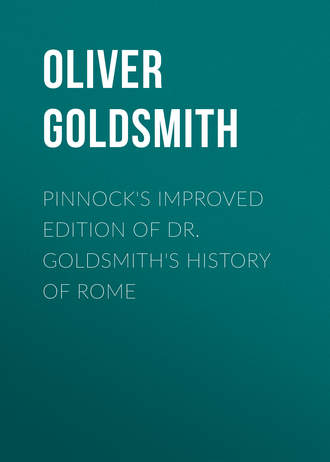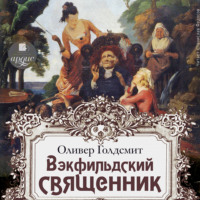 полная версия
полная версияPinnock's improved edition of Dr. Goldsmith's History of Rome
If then we deny the historical truth of a legend which seems to have been universally credited by the Romans, how are we to account for the origin of the tale? Was the tradition of native growth, or was it imported from Greece when the literature of that country was introduced into Latium? These are questions that can only be answered by guess; but perhaps the following theory may in some degree be found satisfactory. We have shown that tradition, from the earliest age, invariably asserted that Pelasgic colonies had formed settlements in central Italy; nothing is more notorious than the custom of the Pelasgic tribes to take the name of their general, or of some town in which they had taken up their temporary residence; now Æne'a and Æ'nus were common names of the Pelasgic towns; the city of Thessaloni'ca was erected on the site of the ancient Æne'a; there was an Æ'nus in Thrace,5 another in Thessaly,6 another among the Locrians, and another in Epi'rus:7 hence it is not very improbable but that some of the Pelasgic tribes which entered Latium may have been called the Æne'adæ; and the name, as in a thousand instances, preserved after the cause was forgotten. This conjecture is confirmed by the fact, that temples traditionally said to have been erected by a people called the Æne'adæ, are found in the Macedonian peninsula of Pall'ene,8 in the islands of De'los, Cythe'ra, Zacy'nthus, Leuca'dia, and Sicily, on the western coasts of Ambra'cia and Epi'rus, and on the southern coast of Sicily.
The account of several Trojans, and especially Æne'as, having survived the destruction of the city, is as old as the earliest narrative of that famous siege; Homer distinctly asserts it when he makes Neptune declare,
– Nor thus can Jove resignThe future father of the Dardan line:The first great ancestor obtain'd his grace,And still his love descends on all the race.For Priam now, and Priam's faithless kind,At length are odious, to the all-seeing mind;On great Æneas shall devolve the reign,And sons succeeding sons the lasting line sustain.ILIAD, xx.But long before the historic age, Phrygia and the greater part of the western shores of Asia Minor were occupied by Grecian colonies, and all remembrance of Æne'as and his followers lost. When the narrative of the Trojan war, with other Greek legends, began to be circulated in Lati'um, it was natural that the identity of name should have led to the confounding of the Æne'adæ who had survived the destruction of Troy, with those who had come to La'tium from the Pelasgic Æ'nus. The cities which were said to be founded by the Æne'adæ were, Latin Troy, which possessed empire for three years; Lavinium, whose sway lasted thirty; Alba, which was supreme for three hundred years; and Rome, whose dominion was to be interminable, though some assign a limit of three thousand years. These numbers bear evident traces of superstitious invention; and the legends by which these cities are successively deduced from the first encampment of Æne'as, are at variance with these fanciful periods. The account that Alba was built by a son of Æne'as, who had been guided to the spot by a white sow, which had farrowed thirty young, is clearly a story framed from the similarity of the name to Albus (white,) and the circumstance of the city having been the capital of the thirty Latin tribes. The city derived its name from its position on the Alban mountain; for Alb, or Alp, signifies lofty in the ancient language of Italy, and the emblem of a sow with thirty young, may have been a significant emblem of the dominion which it unquestionably possessed over the other Latin states. The only thing that we can establish as certain in the early history of La'tium is, that its inhabitants were of a mixed race, and the sources from whence they sprung Pelasgic and Oscan; that is, one connected with the Greeks, and the other with some ancient Italian tribe. We have seen that this fact is the basis of all their traditions, that it is confirmed by the structure of their language, and, we may add, that it is further proved by their political institutions. In all the Latin cities, as well as Rome, we find the people divided into an aristocracy and democracy, or, as they are more properly called, Patricians and Plebeians. The experience of all ages warrants the inference, which may be best stated in the words of Dr. Faber: "In the progress of the human mind there is an invariable tendency not to introduce into an undisturbed community a palpable difference between lords and serfs, instead of a legal equality of rights; but to abolish such difference by enfranchising the serfs. Hence, from the universal experience of history, we may be sure that whenever this distinction is found to exist, the society must be composed of two races differing from each other in point of origin."
The traditions respecting the origin of Rome are innumerable; some historians assert that its founder was a Greek; others, Æneas and his Trojans; and others give the honour to the Tyrrhenians: all, however, agree, that the first inhabitants were a Latin colony from Alba. Even those who adopted the most current story, which is followed by Dr. Goldsmith, believed that the city existed before the time of Rom'ulus, and that he was called the founder from being the first who gave it strength and stability. It seems probable that several villages might have been formed at an early age on the different hills, which were afterwards included in the circuit of Rome; and that the first of them which obtained a decided superiority, the village on the Palatine hill, finally absorbed the rest, and gave its name to "the eternal city".
There seems to be some uncertainty whether Romulus gave his name to the city, or derived his own from it; the latter is asserted by several historians, but those who ascribe to the city a Grecian origin, with some show of probability assert that Romus (another form of Romulus) and Roma are both derived from the Greek ῥωμη, strength. The city, we are assured, had another name, which the priests were forbidden to divulge; but what that was, it is now impossible to discover.
We have thus traced the history of the Latins down to the period when Rome was founded, or at least when it became a city, and shown how little reliance can be placed on the accounts given of these periods by the early historians. We shall hereafter see that great uncertainty rests on the history of Rome itself during the first four centuries of its existence.
CHAPTER III.
THE TOPOGRAPHY OF ROME
Full in the centre of these wondrous worksThe pride of earth! Rome in her glory see. —Thomson.1. The city of Rome, according to Varro, was founded in the fourth year of the sixth Olympiad, B.C. 753; but Cato, the censor, places the event four years later, in the second year of the seventh Olympiad. The day of its foundation was the 21st of April, which was sacred to the rural goddess Pa'les, when the rustics were accustomed to solicit the increase of their flocks from the deity, and to purify themselves for involuntary violation of the consecrated places. The account preserved by tradition of the ceremonies used on this occasion, confirms the opinion of those who contend that Rome had a previous existence as a village, and that what is called its foundation was really an enlargement of its boundaries, by taking in the ground at the foot of the Palatine hill. The first care of Ro'mulus was to mark out the Pomœ'rium; a space round the walls of the city, on which it was unlawful to erect buildings.
2. The person who determined the Pomœ'rium yoked a bullock and heifer to a plough, having a copper-share, and drew a furrow to mark the course of the future wall; he guided the plough so that all the sods might fall inwards, and was followed by others, who took care that none should lie the other way. 3. When he came to the place where it was designed to erect a gate, the plough was taken up,9 and carried to where the wall recommenced. The next ceremony was the consecration of the commit'ium, or place of public assembly. A vault was built under ground, and filled with the firstlings of all the natural productions that sustain human life, and with earth which each foreign settler had brought from his own home. This place was called Mun'dus, and was supposed to become the gate of the lower world; it was opened on three several days of the year, for the spirits of the dead.
4. The next addition made to the city was the Sabine town,10 which occupied the Quirinal and part of the Capitoline hills. The name of this town most probably was Qui'rium, and from it the Roman people received the name Quirites. The two cities were united on terms of equality, and the double-faced Ja'nus stamped on the earliest Roman coins was probably a symbol of the double state. They were at first so disunited, that even the rights of intermarriage did not exist between them, and it was probably from Qui'rium that the Roman youths obtained the wives11 by force, which were refused to their entreaties. 5. The next addition was the Cœlian hill,12 on which a Tuscan colony settled; from these three colonies the three tribes of Ram'nes, Ti'ties, and Lu'ceres were formed. 6. The Ram'nes, or Ram'nenses, derived their name from Rom'ulus; the Tities, or Titien'ses, from Titus Tatius, the king of the Sabines; and the Lu'ceres, from Lu'cumo, the Tuscan title of a general or leader.13 From this it appears that the three tribes14 were really three distinct nations, differing in their origin, and dwelling apart.
7. The city was enlarged by Tullus Hostilius,15 after the destruction of Alba, and the Viminal hill included within the walls; Ancus Martius added mount Aventine, and the Esquiline and Capitoline16 being enclosed in the next reign, completed the number of the seven hills on which the ancient city stood.
8. The hill called Jani'culum, on the north bank of the Tiber, was fortified as an outwork by Ancus Martius, and joined to the city by the bridge; he also dug a trench round the newly erected buildings, for their greater security, and called it the ditch of the Quirites. 9. The public works erected by the kings were of stupendous magnitude, but the private buildings were wretched, the streets narrow, and the houses mean. It was not until after the burning of the city by the Gauls that the city was laid out on a better plan; after the Punic wars wealth flowed in abundantly, and private persons began to erect magnificent mansions. From the period of the conquest of Asia until the reign of Augustus, the city daily augmented its splendour, but so much was added by that emperor, that he boasted that "he found Rome a city of brick, and left it a city of marble."
10. The circumference of the city has been variously estimated, some writers including in their computation a part of the suburbs; according to Pliny it was near twenty miles round the walls. In consequence of this great extent the city had more than thirty gates, of which the most remarkable were the Carmental, the Esquiline, the Triumphal, the Naval, and those called Tergem'ina and Cape'na.
11. The division of the city into four tribes continued until the reign of Augustus; a new arrangement was made by the emperor, who divided Rome into fourteen wards, or regions.17 The magnificent public and private buildings in a city so extensive and wealthy were very numerous, and a bare catalogue of them would fill a volume;18 our attention must be confined to those which possessed some historical importance.
12. The most celebrated and conspicuous buildings were in the eighth division of the city, which contained the Capitol and its temples, the Senate House, and the Forum. The Capitoline-hill was anciently called Saturnius, from the ancient city of Satur'nia, of which it was the citadel; it was afterwards called the Tarpeian mount, and finally received the name of Capitoline from a human head19 being found on its summit when the foundations of the temple of Jupiter were laid. It had two summits; that on the south retained the name Tarpeian;20 the northern was properly the Capitol. 13. On this part of the hill Romulus first established his asylum, in a sacred grove, dedicated to some unknown divinity; and erected a fort or citadel21 on the Tarpeian summit. The celebrated temple of Jupiter Capitoli'nus, erected on this hill, was begun by the elder Tarquin, and finished by Tarquin the Proud. It was burned down in the civil wars between Ma'rius and Syl'la, but restored by the latter, who adorned it with pillars taken from the temple of Jupiter at Olympia. It was rebuilt after similar accidents by Vespa'sian and Domitian, and on each occasion with additional splendour. The rich ornaments and gifts presented to this temple by different princes and generals amounted to a scarcely credible sum. The gold and jewels given by Augustus alone are said to have exceeded in value four thousand pounds sterling. A nail was annually driven into the wall of the temple to mark the course of time; besides this chronological record, it contained the Sibylline books, and other oracles supposed to be pregnant with the fate of the city. There were several other temples on this hill, of which the most remarkable was that of Jupiter Feretrius, erected by Romulus, where the spolia opima were deposited.
14. The Forum, or place of public assembly, was situated between the Palatine and Capitoline hills. It was surrounded with temples, basilicks,22 and public offices, and adorned with innumerable statues.23 On one side of this space were the elevated seats from which the Roman magistrates and orators addressed the people; they were called Rostra, because they were ornamented with the beaks of some galleys taken from the city of Antium. In the centre of the forum was a place called the Curtian Lake, either from a Sabine general called Curtius, said to have been smothered in the marsh which was once there; or from24 the Roman knight who plunged into a gulf that opened suddenly on the spot. The celebrated temple of Ja'nus, built entirely of bronze, stood in the Forum; it is supposed to have been erected by Numa. The gates of this temple were opened in time of war, and shut during peace. So continuous we're the wars of the Romans, that the gates were only closed three times during the space of eight centuries. In the vicinity stood the temple of Concord, where the senate frequently assembled, and the temple of Vesta, where the palla'dium was said to be deposited.
15. Above the rostra was the Senate-house, said to have been first erected by Tullus Hostilius; and near the Comitium, or place of meeting for the patrician Curiæ.25 This area was at first uncovered, but a roof was erected at the close of the second Pu'nic war.
16. The Cam'pus Mar'tius, or field of Mars, was originally the estate of Tarquin the Proud, and was, with his other property, confiscated after the expulsion of that monarch. It was a large space, where armies were mustered, general assemblies of the people held, and the young nobility trained in martial exercises. In the later ages, it was surrounded by several magnificent structures, and porticos were erected, under which the citizens might take their accustomed exercise in rainy weather. These improvements were principally made by Marcus Agrippa, in the reign of Augustus. 17. He erected in the neighbourhood, the Panthe'on, or temple of all the gods, one of the most splendid buildings in ancient Rome. It is of a circular form, and its roof is in the form of a cupola or dome; it is used at present as a Christian church. Near the Panthe'on were the baths and gardens which Agrippa, at his death, bequeathed to the Roman people.
18. The theatres and circi for the exhibition of public spectacles were very numerous. The first theatre was erected by Pompey the Great; but the Circus Maximus, where gladiatorial combats were displayed, was erected by Tarquinus Priscus; this enormous building was frequently enlarged, and in the age of Pliny could accommodate two hundred thousand spectators. A still more remarkable edifice was the amphitheatre erected by Vespasian, called, from its enormous size, the Colosse'um.
19. Public baths were early erected for the use of the people, and in the later ages were among the most remarkable displays of Roman luxury and splendour. Lofty arches, stately pillars, vaulted ceilings, seats of solid silver, costly marbles inlaid with precious stones, were exhibited in these buildings with the most lavish profusion.
20. The aqueducts for supplying the city with water, were still more worthy of admiration; they were supported by arches, many of them a hundred feet high, and carried over mountains and morasses that might have appeared insuperable. The first aqueduct was erected by Ap'pius Clo'dius, the censor, four hundred years after the foundation
of the city; but under the emperors there were not less than twenty of these useful structures, and such was the supply of water, that rivers seemed to flow through the streets and sewers. Even now, though only three of the aqueducts remain, such are their dimensions that no city in Europe has a greater abundance of wholesome water than Rome.
21. The Cloa'cæ, or common sewers, attracted the wonder of the ancients themselves; the largest was completed by Tarquin the Proud. The innermost vault of this astonishing structure forms a semicircle eighteen Roman palms wide, and as many high: this is inclosed in a second vault, and that again in a third, all formed of hewn blocks of pepenno, fixed together without cement. So extensive were these channels, that in the reign of Augustus the city was subterraneously navigable.
22. The public roads were little inferior to the aqueducts and Cloa'cæ in utility and costliness; the chief was the Appian road from Rome to Brundu'sium; it extended three hundred and fifty miles, and was paved with huge squares through its entire length. After the lapse of nineteen centuries many parts of it are still as perfect as when it was first made.
23. The Appian road passed through the following towns; Ari'cia, Fo'rum Ap'pii, An'xur or Terraci'na, Fun'di, Mintur'næ, Sinue'ssa, Cap'ua, Can'dium, Beneven'tum, Equotu'ticum, Herdo'nia, Canu'sium, Ba'rium, and Brundu'sium. Between Fo'rum Ap'pii and Terraci'na lie the celebrated Pomptine marshes, formed by the overflowing of some small streams. In the flourishing ages of Roman history these pestilential marshes did not exist, or were confined to a very limited space; but from the decline of the Roman empire, the waters gradually encroached, until the successful exertions made by the Pontiffs in modern times to arrest their baleful progress. Before the drainage of Pope Sixtus, the marshes covered at least thirteen thousand acres of ground, which in the earlier ages was the most fruitful portion of the Italian soil.
Questions for Examination.
1. When was Rome founded?
2. What ceremonies were used in determining the pomcerium?
3. How was the comitium consecrated?
4. What was the first addition made to Rome?
5. What was the next addition?
6. Into what tribes were the Romans divided?
7. What were the hills added in later times to Rome?
8. Had the Romans any buildings north of the Tiber?
9. When did Rome become a magnificent city?
10. What was the extent of the city?
11. How was the city divided?
12. Which was the most remarkable of the seven hills?
13. What buildings were on the Capitoline hill?
14. What description is given of the forum?
15. Where was the senate-house and comitium?
16. What use was made of the Campus Martius?
17. What was the Pantheon?
18. Were the theatres and circii remarkable?
19. Had the Romans public baths?
20. How was the city supplied with water?
21. Were the cloacæ remarkable for their size?
22. Which was the chief Italian road?
23. What were the most remarkable places on the Appian road?
CHAPTER IV.
THE ROMAN CONSTITUTION
As once in virtue, so in vice extreme,This universal fabric yielded loose,Before ambition still; and thundering down,At last beneath its ruins crush'd a world. —Thomson.I. The most remarkable feature in the Roman constitution is the division of the people into Patricians and Plebeians, and our first inquiry must be the origin of this separation. It is clearly impossible that such a distinction could have existed from the very beginning, because no persons would have consented in a new community to the investing of any class with peculiar privileges. We find that all the Roman kings, after they had subdued a city, drafted a portion of its inhabitants to Rome; and if they did not destroy the subjugated place, garrisoned it with a Roman colony. The strangers thus brought to Rome were not admitted to a participation of civic rights; they were like the inhabitants of a corporate town who are excluded from the elective franchise: by successive immigrations, the number of persons thus disqualified became more numerous than that of the first inhabitants or old freemen, and they naturally sought a share in the government, as a means of protecting their persons and properties. On the other hand, the men who possessed the exclusive power of legislation, struggled hard to retain their hereditary privileges, and when forced to make concessions, yielded as little as they possibly could to the popular demands. Modern history furnishes us with numerous instances of similar struggles between classes, and of a separation in interests and feelings between inhabitants of the same country, fully as strong as that between the patricians and plebeians at Rome.
2. The first tribes were divided by Ro'mulus into thirty cu'riæ, and each cu'ria contained ten gentes or associations. The individuals of each gens were not in all cases, and probably not in the majority of instances, connected by birth;26 the attributes of the members of a gens, according to Cicero, were, a common name and participation in private religious rites; descent from free ancestors; the absence of legal disqualification. 3. The members of these associations were united by certain laws, which conferred peculiar privileges, called jura gentium; of these the most remarkable were, the succession to the property of every member who died without kin and intestate, and the obligation imposed on all to assist their indigent fellows under any extraordinary burthen.27 4. The head of each gens was regarded as a kind of father, and possessed a paternal authority over the members; the chieftancy was both elective and hereditary;28 that is, the individual was always selected from some particular family.
5. Besides the members of the gens, there were attached to it a number of dependents called clients, who owed submission to the chief as their patron, and received from him assistance and protection. The clients were generally foreigners who came to settle at Rome, and not possessing municipal rights, were forced to appear in the courts of law, &c. by proxy. In process of time this relation assumed a feudal form, and the clients were bound to the same duties as vassals29 in the middle ages.
6. The chiefs of the gentes composed the senate, and were called "fathers," (patres.) In the time of Romulus, the senate at first consisted only of one hundred members, who of course represented the Latin tribe Ramne'nses; the number was doubled after the union with the Sabines, and the new members were chosen from the Titienses. The Tuscan tribe of the Lu'ceres remained unrepresented in the senate until the reign of the first Tarquin, when the legislative body received another hundred30 from that tribe. Tarquin the elder was, according to history, a Tuscan Iticumo, and seems to have owed his elevation principally to the efforts of his compatriots settled at Rome. It is to this event we must refer, in a great degree, the number of Tuscan ceremonies which are to be found in the political institutions of the Romans.
7. The gentes were not only represented in the senate, but met also in a public assembly called "comitia curiata." In these comitia the kings were elected and invested with royal authority. After the complete change of the constitution in later ages, the "comitia curiata"31 rarely assembled, and their power was limited to religious matters; but during the earlier period of the republic, they claimed and frequently exercised the supreme powers of the state, and were named emphatically, The People.








